This article is from the WatchTime Archives.
Fifteen years after its introduction, the Lange 1 Time Zone from A. Lange & Söhne was equipped with a new manufacture caliber. The time in two different time zones can be read intuitively from the dial. But this watch offers much more, as we can confirm after scrutinizing one we were able to preview before the watch’s official launch.
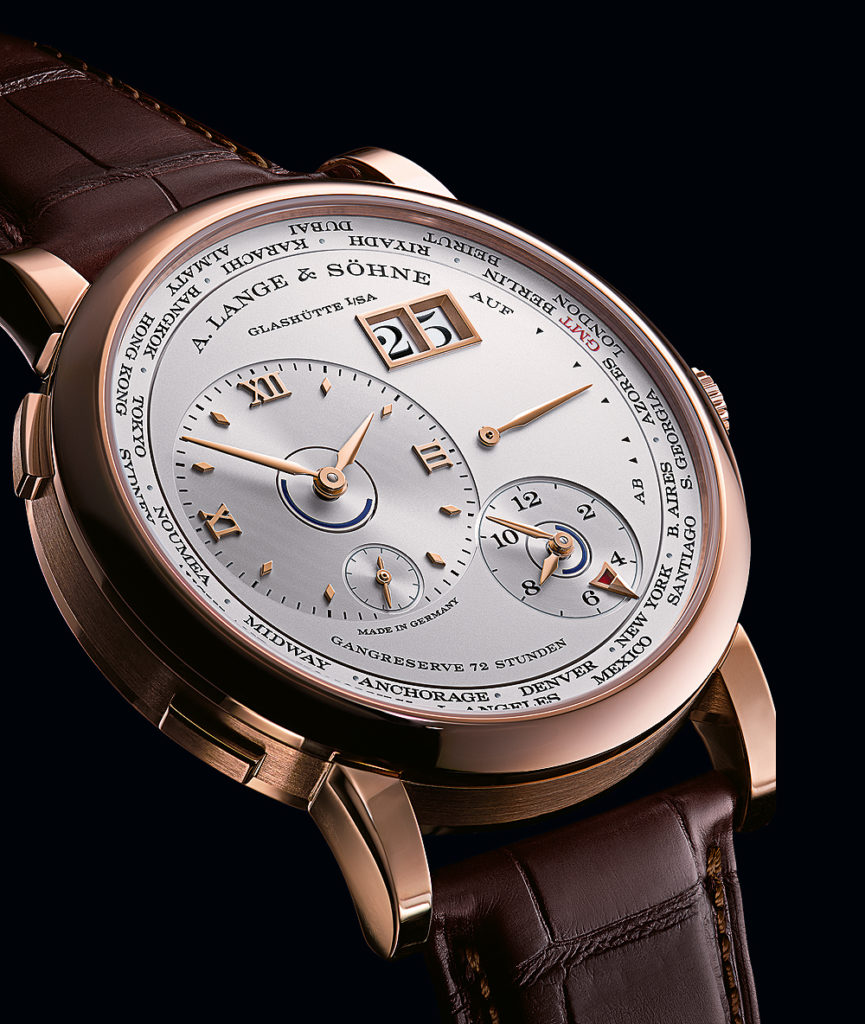
A second time zone ranks among the most useful added functions a watch can have, along with a date, at least since people began traveling around the globe, working and communicating with associates in different time zones. This complication is extremely relevant nowadays, but it’s not as new as you might think. Soon after the International Meridian Conference in 1884, inventive watchmakers in Glashütte had devised and began making pocketwatches with two separately adjustable time displays. These antique timepieces are now coveted collectors’ items.
The new Lange 1 Time Zone, the watch we were able to preview, shows your home time on one circle and another, freely selectable time zone, in a second circle. The entire ensemble is clear, intuitive and, needless to say, designed in classic Lange 1 style. The large, off-center time circle on the left side of the dial shows the time at your current location or in your home time zone. Meanwhile, the time in a different zone is shown on a second, smaller time circle at the lower right, at the same position where the small seconds hand rotates in the classic Lange 1. The small seconds truly deserves its name because this is shown on a petite disk at 6 on the off-center main time subdial. This was the very arrangement that was used on the face of the first Lange 1 Time Zone, which debuted in 2005. Also familiar from the original Lange 1 is the city ring along the dial’s circumference, where two dozen place names correspond to the Earth’s 24 time zones. The positioning of this place-name ring lets you instantly see which zone’s time is currently displayed on the second time circle. The functionality of the Lange 1 Time Zone thus far exceeds that of a watch with a second, separately adjustable time display. Without claiming to be a world-time watch, it can still show all of the world’s time zones. This goal was already explicitly stated in the specs for the original Lange 1 Time Zone, for which the first sketches were available in fall 2002.
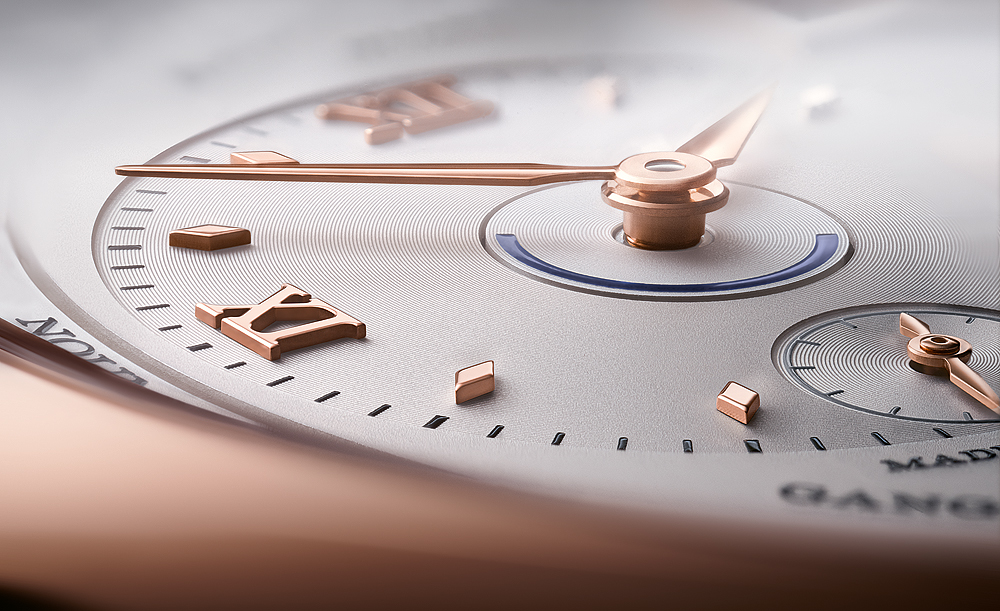
Two Disks Rotate to Indicate Day and Night
Times change. And some places alter their time zones. Although these zones were theoretically defined according to geographical longitude at the International Meridian Conference in 1884, in practice — then as now — they are far more difficult to define according to shifting political boundaries and national interests. This has practical consequences for watches with settings such as those offered by the Lange 1 Time Zone. Russia, for example, abolished two time zones between 2010 and 2014 and also maintained daylight saving time all year round for over three years starting in 2011. Now the semiannual changeover to daylight saving time is not taking place at all in Russia. To circumvent this confusion, “Moscow” was replaced by “ Riyadh” on the city ring of the Lange 1 Time Zone. Venezuela similarly changed its time zone, so “Caracas” was removed and “Santiago” added to the city ring. And these are only two of the perplexing updates.
The day-night indicators, which are very useful for a watch of this kind, have been completely redesigned on the new Lange 1 Time Zone. They appear as two disks, one at the center of the time circle for the home time and its counterpart at the center of the subdial for the second time zone.
The disks, printed with dark blue semicircular arcs to symbolize night, rotate once around their own axis every 24 hours while the corresponding hour-hands complete two orbits in the same interval. If the hour hands are above the blue arcs, then it is night, or more specifically, the period between 6 p.m. and 6 a.m. If the hour hands are in the light-colored area of the dial, then the time shown refers to a daytime hour between 6 a.m. and 6 p.m. These displays are not only intuitively understandable, but also look very harmonious compared to the formerly off-center positioning of the day/night disks on the old Lange 1 Time Zone.
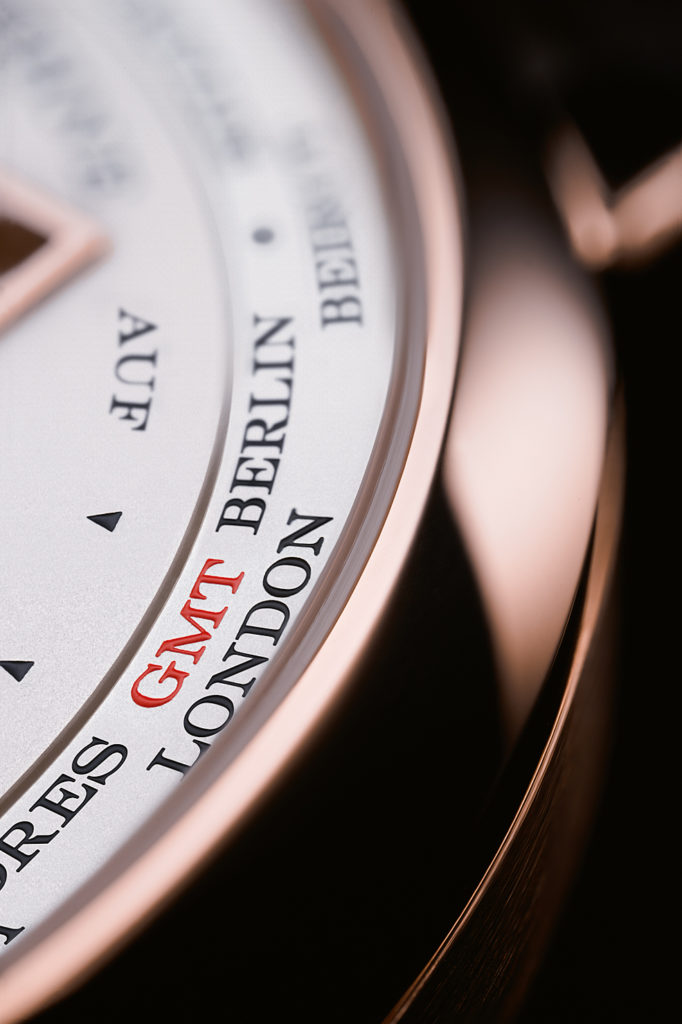
Set the Second Time Zone After Synchronization
The convenient way to set the second time zone was adapted from the previous model. It is done by means of a ring, marked with the corresponding reference locations, that clicks into place in 24 steps and a pusher at 8 o’clock. When you press this pusher, the hour hand of the second time zone advances by one hour. At the same time, the city ring jumps one time zone onward from west to east. A golden arrow appliqué at the 5 in the small time circle indicates the reference point for the respective time zone. All the while, the already-set home time remains unchanged on the large time circle.
Before you choose a second time zone for whatever purpose you may have in mind — for example, to show the time in a business partner’s zone or at an intended destination — it’s recommended to synchronize the watch first. To start this process, press the pusher at the 8 one or more times to move the city ring into the desired position. It aligns with home time at the golden arrowhead. To set the hands, pull the knurled crown to the second position. This is easily accomplished with two fingernails. And the crown snaps smartly into place thanks to a secure detent. Now both pairs of hands move synchronously when you turn the crown — unless you press and hold down the pusher at the 8, thus preventing the hour hand for the second time zone from moving. This allows the two time displays to be synchronized. But be careful: precisely the right amount of pressure must be applied to the pusher. If you press and hold the pusher down too gently, the hour hand for the second time zone will continue to turn; but if you press the button with too much force, the city ring along the dial’s periphery will jump forward and you’ll have to start the procedure all over again. The synchronization works best if you perform the process in the counterclockwise direction. When setting the time, it is also important to make sure that the day-night indicator and the date display are in harmony. If necessary, this can be corrected by pressing the button at the 10. Unlike its counterpart, this pusher is very easy to operate. If you then set the watch to the nearest second (for which a stop-seconds function is provided), then two time zones will run perfectly parallel to one another.
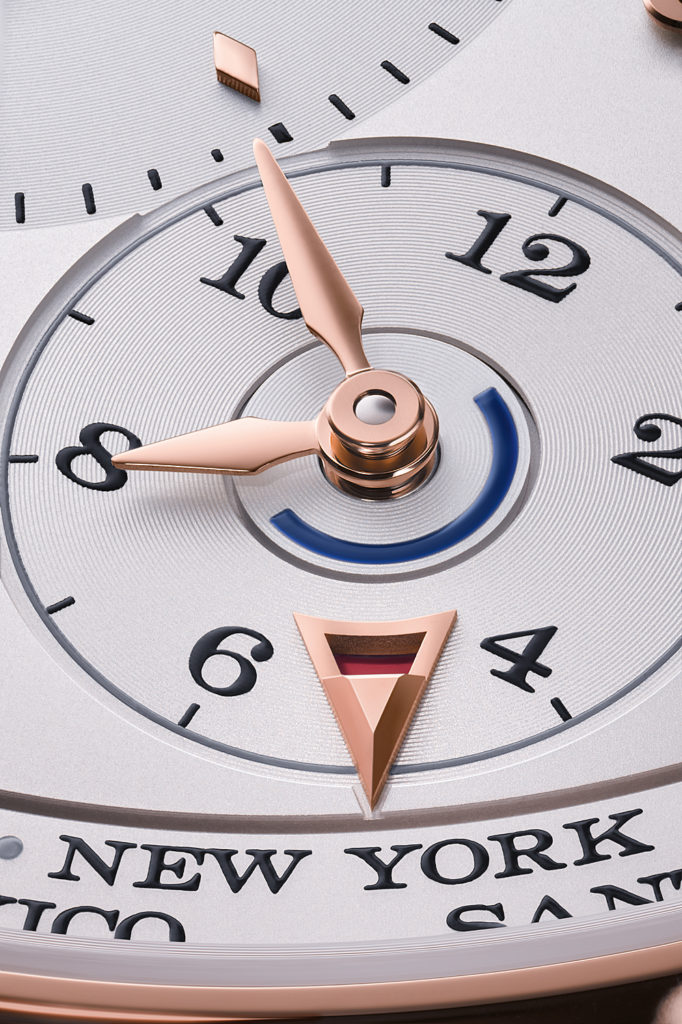
To set a business partner’s time zone on the small time circle, simply press the pusher at the 8, which causes the city ring along the dial’s circumference to advance in single-hour increments until the desired reference city is opposite the tip of the golden arrowhead. The hour hand in the small time circle jumps accordingly. When the process is complete, this hand shows the corresponding hour in the desired second time zone.
When Traveling, Press the Button to Preserve Home Time
The same procedure as described above for synchronization is recommended if you want to change the main time during a longer stay in a new time zone. While you reset the new main time on the large time circle via the crown, you press the pusher at the 8 to keep your home time unchanged on the second time circle. The city ring is always linked to the second time zone, while the outsize date display advances in sync with the time shown on the main time circle. If jet lag is keeping you up late and your watch is running, you can observe the date display gradually advance during the first half hour after midnight.
The real artistry of the Lange 1 Time Zone becomes apparent when you switch the home time onto the second time circle and vice versa. Depress and hold down the pusher at the 8 and turn the hands of the main time counterclockwise via the crown until they reach the setting for the current second time zone. Meanwhile the hour hand on the subdial for the second time zone remains motionless. But when performing this operation, make sure that the day/night display is correct. Afterward, press the pusher at the 8 until the city name of your (former) home time appears opposite the arrow appliqué.
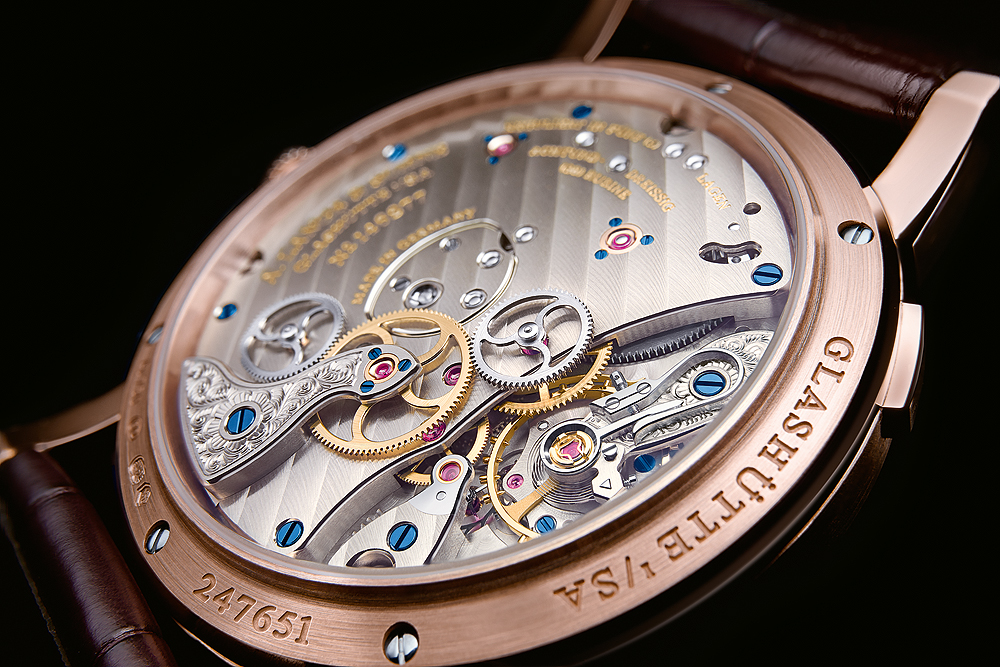
The Arrow Appliqué is Handsome and Multifunctional
This watch’s new daylight saving time indicator is also shown using the arrow appliqué. If the small window inside the arrow is filled with red, this means that daylight saving time is in effect at the corresponding location. If this is the case, then you need to mentally add one hour to the time shown by the second time zone display. If standard time is valid all year round at the location, then a white background appears in the little window on the arrow and the display automatically shows the correct time: no mental arithmetic is necessary.
The technical solution that makes this possible involves a coding on the underside of the city ring. This is new, of course, because the first Lange 1 Time Zone didn’t have a daylight saving time indicator. A long lever under the dial moves a red-and-white arc, which shows the daylight saving time coding of the city ring in the small window of the arrow appliqué.
This cadrature belongs to new manual-winding Lange manufacture Caliber L141.1, which means that all models in the Lange 1 watch family are now equipped with new movements rather than the original basic Caliber L901. The experience gained from 65 previous calibers has been incorporated into this latest one. Compared to the previous model, a single barrel provides the Lange 1 Time Zone with its 72-hour power reserve. This is why the German inscription for double barrel that was on the dial of the earlier model has been replaced by the German phrase “Gangreserve 72 Stunden” for 72-hour power reserve. The German words “Auf” (up) and “Ab” (down) that typically appear on Lange’s dials have been preserved unchanged at the 2 and the 4 on the right side of the face. Like the significant big date window at 1 o’clock, the positioning of the hands’ axes also follow Lange’s well-thought-out aesthetics in which nothing is left to chance. The time circles with Roman numerals and golden rhombic appliqués for the main time, and the Arabic numerals printed in black for the second time zone, are also nearly unchanged. Golden leaf-shaped hands are used throughout.
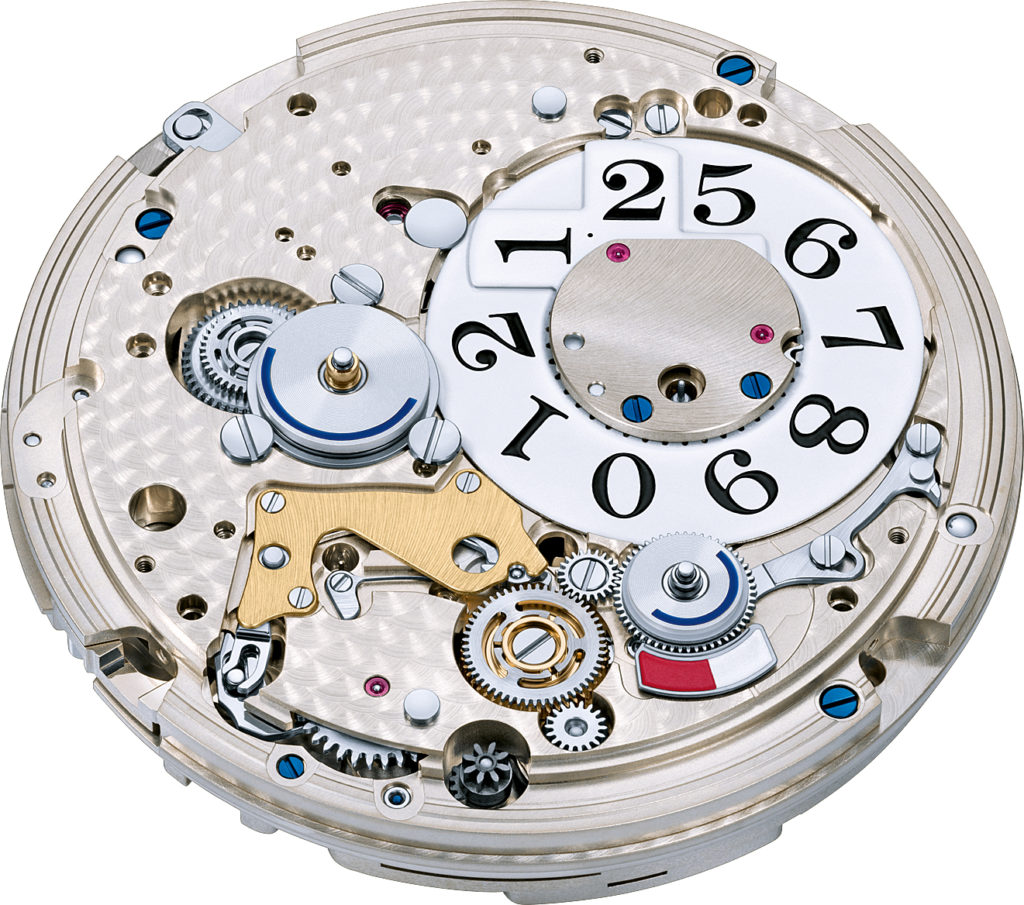
Travel Around the World at Will
To conserve space, the three gears that comprise the drive mechanism for the second time zone were already moved to the back of Caliber L901’s three-quarter plate, where they remain in new Caliber L141.1. Beautiful curved spokes adorn the wheels of the small transmission mechanism from the minute wheel of the main time zone to the minute wheel of the second time zone. Similarly shaped wheels were used on antique lathes. In typical Glashütte style, the large golden intermediate wheel is mounted in a hand-engraved cock with a screwed gold chaton.
Caliber L141.1 is, of course, manufactured in accordance with “the highest Lange quality criteria.” Its technical and aesthetic details include a classic screw balance that vibrates at 21,600 semi-oscillations per hour, a free-swinging balance spring made by Lange, a three-quarter plate crafted from nickel silver, two additional screwed gold chatons, blued screws and a hand-engraved balance cock, on which the swan’s neck fine adjustment for setting the beat is mounted. The beat is perfectly adjusted, although this specimen ran very slightly slow on our timing machine. This fact, however, is excluded from our evaluation because this particular Lange 1 Time Zone is a preview model and not a test piece. That is why we soon had to bid farewell to this beautiful timepiece from Glashütte — and also why we couldn’t keep it long enough to check its rate performance on the wrist over several days.
We would have loved to take this watch along on journeys around the world, but unfortunately we had neither the time nor the opportunity for that adventure. So it’s a good thing that we could circle the globe simply by operating this watch’s time zone function — and do it all without leaving home.
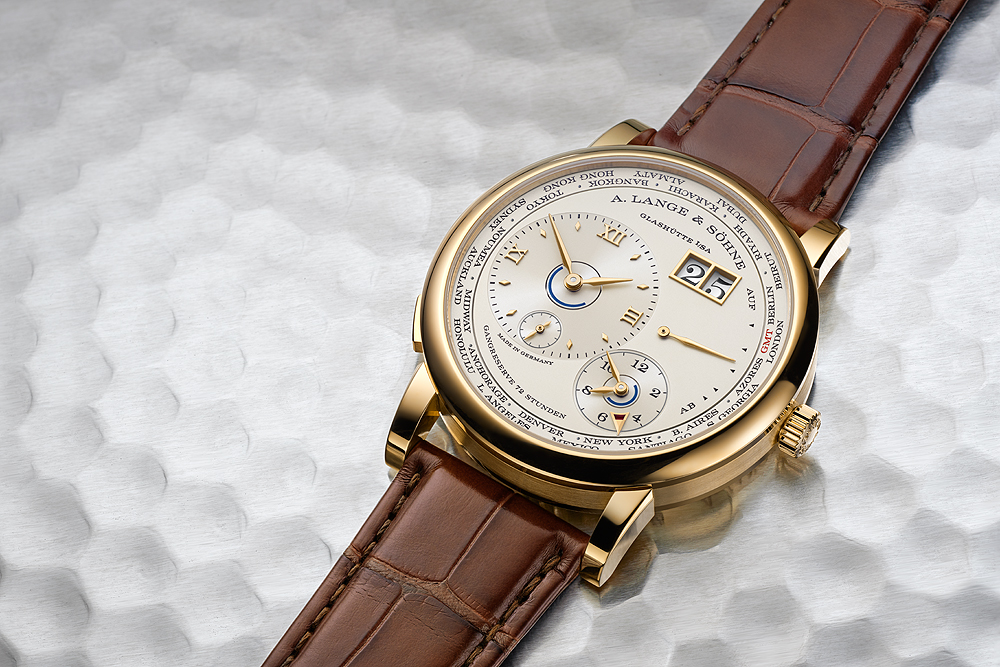
SPECS:
Manufacturer: A. Lange Uhren GmbH, Ferdinand-Adolph-Lange-Platz 1, 01768, Glashütte, Germany
Reference number: 136.032 (Pre-series model for editorial preview)
Functions: Off-center dial for hour and minute with integrated subdial for the seconds, second time zone, ring-shaped day-night displays for both time zones, city ring for second time zone, summer-time display, big date, power-reserve display
Movement: In-house Caliber L141.1, hand- winding, 21,600 vph, 38 rubies, 3 screwed gold chatons, Lange hairspring, screw balance, Kif shock absorption, swan’s neck fine adjustment, 72-hour (3 days) power reserve, diameter = 34.1 mm, height = 6.70 mm
Case: Rose gold, sapphire crystals rated 9 on the Mohs scale above the dial and in the back, water resistant to 30 m
Strap and clasp: Hand-sewn, reddish-brown leather strap, rose-gold pin buckle
Dimensions: Diameter = 41.97 mm, height = 10.94 mm, weight = 114.0 g
Variations: With white-gold case (Ref. 136.029, $52,900); with yellow-gold case (Limited edition of 100 pieces, Ref. 136.021, $56,000)
Price: $52,900

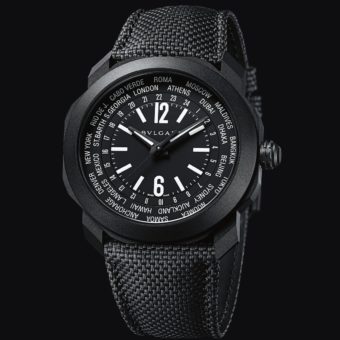

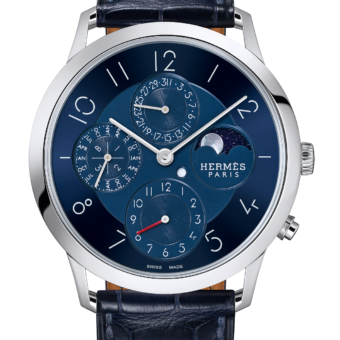


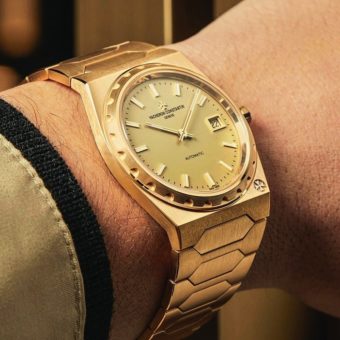
I find your new dual time zone in the rose gold stunning. I would like to purchase it when available. Thanks. Having been to the factory several times and own many of the watches, it is my favorite brand and my soon to be 100 year old mother would like to purchase it for me. Although she is in good health for 99, she will turn 100 on February 7 and would like to purchase it for me. Anything you can do to expedite purchase would be greatly appreciated. You can reach me at 12022559540. Thanks!
Thank you for the review of an exceptionally beautiful and fine watch.
Grail!
A splendid watch. A great read. Thank you.
Wow what a gorgeous watch